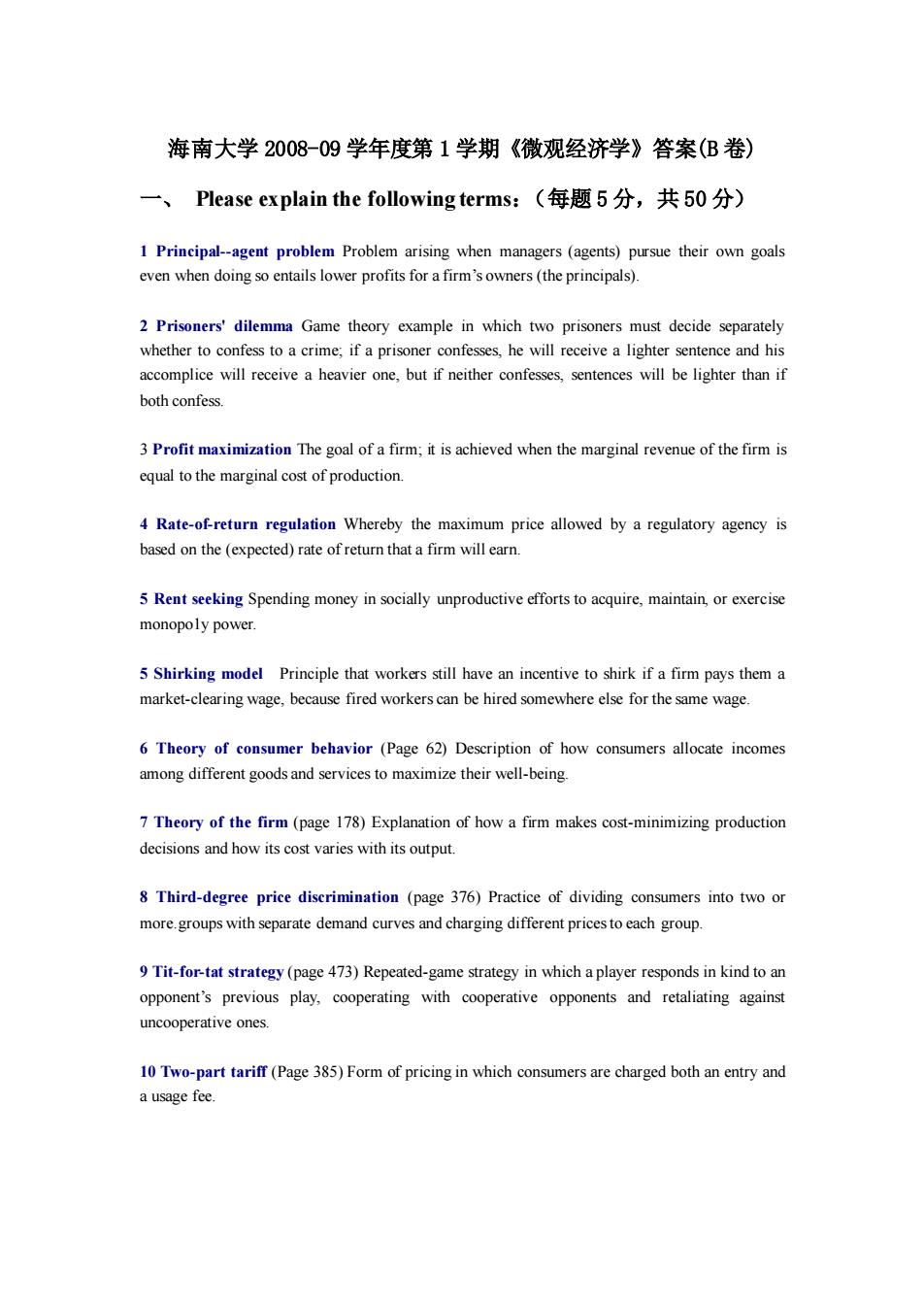
海南大学2008-09学年度第1学期《微观经济学》答案(B卷) 一、Please explain the following terms:(每题5分,共50分) 1 Principal-agent problem Problem arising when managers(agents)pursue their own goals even when doing so entails lower profits for a firm's owners(the principals). 2 Prisoners'dilemma Game theory example in which two prisoners must decide separately whether to confess to a crime,if a prisoner confesses,he will receive a lighter sentence and his accomplice will receive a heavier one,but if neither confesses,sentences will be lighter than if both confess. goal of a isachieved when the marginal revenue of the firm is equal to the marginal cost of production. 4 Rate-of-return regulation Whereby the maximum price allowed by a regulatory agency is based on the (expected)rate of retu that a firm will ear 5 Rent seeking Spending money in socially unproductive efforts to acquire,maintain,or exercise monopoly power. 5Shirking model Principle that workers still have an incentive to shirk if a firm pays them a market-clearing wage,because fired workers can be hired somewhere else for the same wage. 6Theory of consumer behavior (Page 62)Description of how consumers allocate income among different goods and services to maximize their well-being 7 Theory of the firm(p age 178)Explanation of how a firm makes cost-minimizing production decisions and how with its oupu 8 Third-degree price discrimination (page 376)Practice of dividing consumers into two or more.groups with separate demand curves and charging different pricestoeach group. Tit-for-tat strategy (page 473)Repeated-game strategy in which aplayer responds in kind to an opponent's previous play,cooperating with cooperative opponents and retaliating against uncooperative ones. 10Two-parttarif(Page 385)Form of pricing in which consumers are charged both an entry and a usage fee
海南大学 2008-09 学年度第 1 学期《微观经济学》答案(B 卷) 一、 Please explain the following terms:(每题 5 分,共 50 分) 1 Principal-agent problem Problem arising when managers (agents) pursue their own goals even when doing so entails lower profits for a firm’s owners (the principals). 2 Prisoners' dilemma Game theory example in which two prisoners must decide separately whether to confess to a crime; if a prisoner confesses, he will receive a lighter sentence and his accomplice will receive a heavier one, but if neither confesses, sentences will be lighter than if both confess. 3 Profit maximization The goal of a firm; it is achieved when the marginal revenue of the firm is equal to the marginal cost of production. 4 Rate-of-return regulation Whereby the maximum price allowed by a regulatory agency is based on the (expected) rate of return that a firm will earn. 5 Rent seeking Spending money in socially unproductive efforts to acquire, maintain, or exercise monopo1y power. 5 Shirking model Principle that workers still have an incentive to shirk if a firm pays them a market-clearing wage, because fired workers can be hired somewhere else for the same wage. 6 Theory of consumer behavior (Page 62) Description of how consumers allocate incomes among different goods and services to maximize their well-being. 7 Theory of the firm (page 178) Explanation of how a firm makes cost-minimizing production decisions and how its cost varies with its output. 8 Third-degree price discrimination (page 376) Practice of dividing consumers into two or more.groups with separate demand curves and charging different prices to each group. 9 Tit-for-tat strategy (page 473) Repeated-game strategy in which a player responds in kind to an opponent’s previous play, cooperating with cooperative opponents and retaliating against uncooperative ones. 10 Two-part tariff (Page 385) Form of pricing in which consumers are charged both an entry and a usage fee
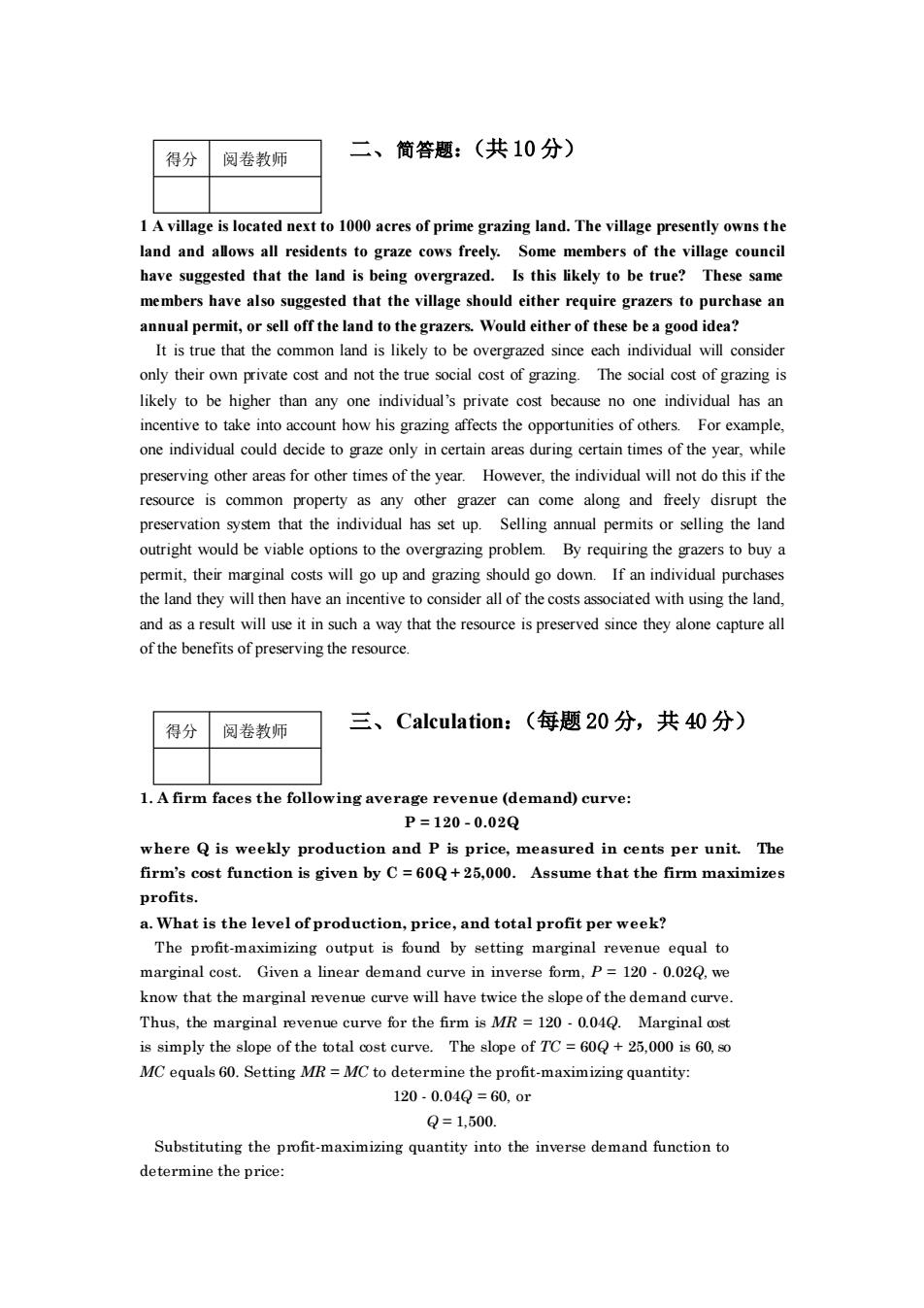
得分阅卷教师 二、简答题:(共10分) 1A village is located next to 1000 acres of prime grazing land.The village presently owns the land and allows all reside nts to graze cows freely. me members of the village counci have suggested that the land is being overgrazed.Is this likely to be true? These same members have also suggested that the village should either require grazers to purchase an annual permit.or sell off the land to the grazers.would either of these be a good idea? It is tue that the cmmon land is likely to be overgazed since each individual will consider only their own private cost and not the true social cost of grazing The social cost of grazing is likely to be higher than any one individual's private cost because no one individual has an incentive to take into account how his grazing affects the opportunities of others.For example. ne individual ou decide in certain reas during certain times of the year,while preserving other areas for other times of the year.However,the individual will not do this if the resource is common property as any other grazer can come along and freely disrupt the preservation system that the individual has set up.Selling annual permits or selling the land wou be viable problem.buy a permit,their marginal costs will go up and grazing should go down.If an individual purchase the land they will then have an incentive to consider all of the costs associated with using the land. and as a result will use it in such a way that the resource is preserved since they alone capture al of the benefits of preserving the resource 得分阅卷教师 三、Calculation:(每题20分,共40分) 1.A firm faces the following average revenue (demand)curve: P=120-0.02Q per unit.The Assume that th e firm maximizes profits. a.What is the level of production,price,and total profit per week? know that the marginal revenue curve will have twice the slope of the demand curve Thus,the marginal revenue curve for the firm is MR =120-0.04Q.Marginal oost is simply the slope of the total cost curve.The slope of TC=60Q+25.000 is 60.so .SettingMR=MC to determine the profit-maximizing quantity 120.0.04Q=60,01 Q=1,500. Substituting the profit-maximizing quantity into the inverse demand function to determine the price:
二、简答题:(共 10 分) 1 A village is located next to 1000 acres of prime grazing land. The village presently owns the land and allows all residents to graze cows freely. Some members of the village council have suggested that the land is being overgrazed. Is this likely to be true? These same members have also suggested that the village should either require grazers to purchase an annual permit, or sell off the land to the grazers. Would either of these be a good idea? It is true that the common land is likely to be overgrazed since each individual will consider only their own private cost and not the true social cost of grazing. The social cost of grazing is likely to be higher than any one individual’s private cost because no one individual has an incentive to take into account how his grazing affects the opportunities of others. For example, one individual could decide to graze only in certain areas during certain times of the year, while preserving other areas for other times of the year. However, the individual will not do this if the resource is common property as any other grazer can come along and freely disrupt the preservation system that the individual has set up. Selling annual permits or selling the land outright would be viable options to the overgrazing problem. By requiring the grazers to buy a permit, their marginal costs will go up and grazing should go down. If an individual purchases the land they will then have an incentive to consider all of the costs associated with using the land, and as a result will use it in such a way that the resource is preserved since they alone capture all of the benefits of preserving the resource. 三、Calculation:(每题 20 分,共 40 分) 1. A firm faces the following average revenue (demand) curve: P = 120 - 0.02Q where Q is weekly production and P is price, measured in cents per unit. The firm’s cost function is given by C = 60Q + 25,000. Assume that the firm maximizes profits. a. What is the level of production, price, and total profit per week? The profit-maximizing output is found by setting marginal revenue equal to marginal cost. Given a linear demand curve in inverse form, P = 120 - 0.02Q, we know that the marginal revenue curve will have twice the slope of the demand curve. Thus, the marginal revenue curve for the firm is MR = 120 - 0.04Q. Marginal cost is simply the slope of the total cost curve. The slope of TC = 60Q + 25,000 is 60, so MC equals 60. Setting MR = MC to determine the profit-maximizing quantity: 120 - 0.04Q = 60, or Q = 1,500. Substituting the profit-maximizing quantity into the inverse demand function to determine the price: 得分 阅卷教师 得分 阅卷教师
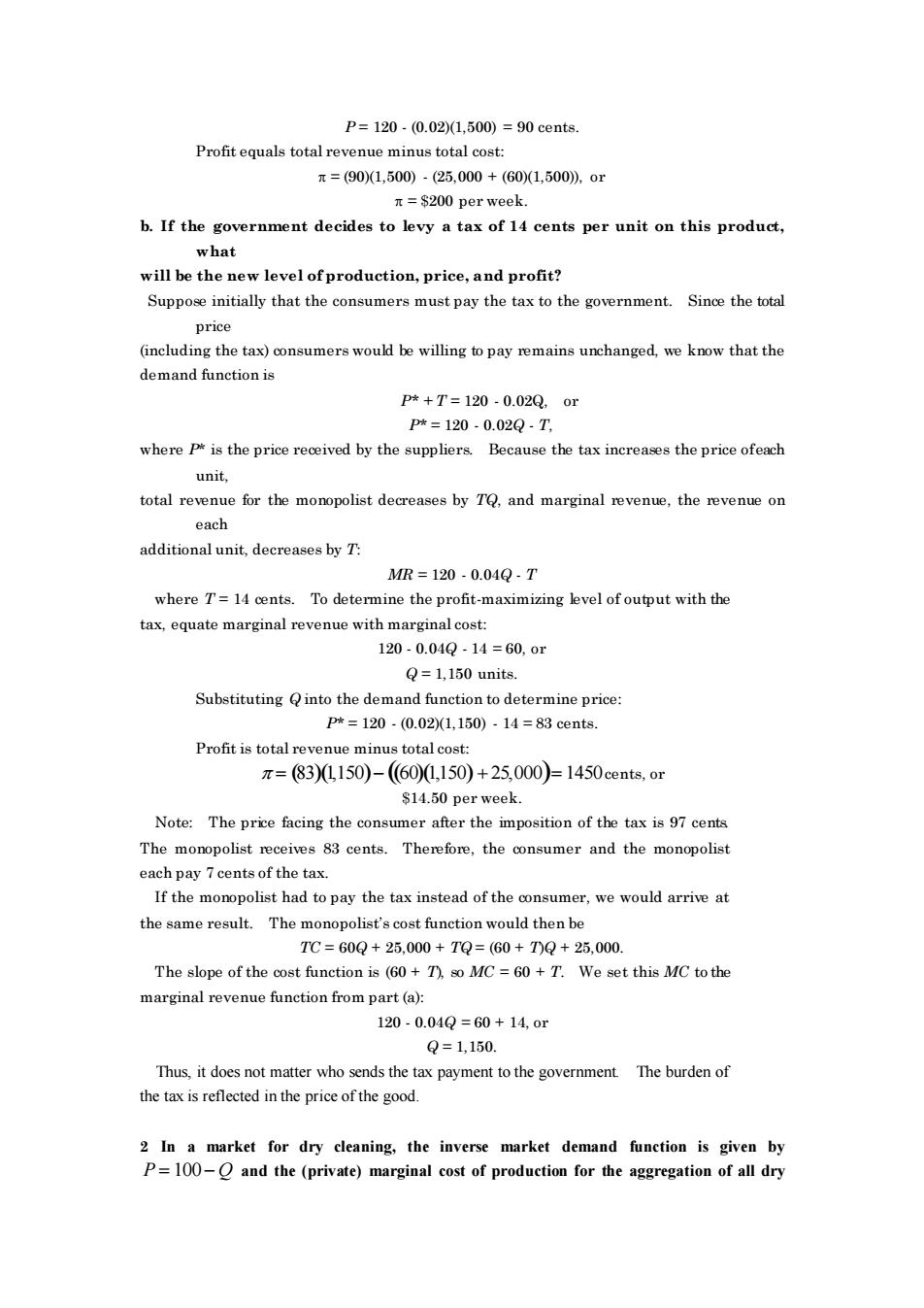
P=120.0.021,500)=90 cents Profit equals total revenue minus total cost: 元=(901,500)·(25,000+(601,500).0r π=S200 per week. b.If the government decides to levy a tax of 14 cents per unit on this product what will be the new level ofproduction,price,and profit? Suppose initially that the consumers must pay the tax to the government.Since the total (including the tax)consumers would be willing topay remains unchanged,we know that the demand function is p*+T=120.0.02Q,or P*=120.0.02Q-T. whereis the price reeived by the Because the tax inre the price ofech unit. total revenue for the monopolist decreases by T,and marginal revenue,the revenue on each additional unit,decreases by T MR=120-0.04Q.T where T=14 cents.To determine the profit-maximizing level of output with the tax.equate marginal revenue with marginal cost: 120.0.04Q-14=60,0 Q=1,150 units. Substituting Qinto the demand function to determine price p*=120-(0.021,150)-14=83 cents. Profit is total minus total cost π=83)0150)-(60)0,150)+25,000)=1450 cents,or $14.50 per week. Note:The price facing the consumer after the imposition of the tax is 97 cents The monopolist receives8 cents.Therefore,the consumer and the monopolist each pay 7 cents of the tax. If the monopolist had to pay the tax instead of the consumer,we would arrive at the same result.The monopolist's cost function would then be TC=60Q+25.000+TQ=(60+TQ+25.000. The slope of the cost function+T).MC=60+T.We set this MC tothe marginal revenue function from part(a): 120.0.04Q=60+14.or Q=1,150. Thus,it does not matter who sends the tax payment to the government The burden of the tax is reflected in the price of the good. -and the (private)marginal cost of production for the aggregation of all dry
P = 120 - (0.02)(1,500) = 90 cents. Profit equals total revenue minus total cost: = (90)(1,500) - (25,000 + (60)(1,500)), or = $200 per week. b. If the government decides to levy a tax of 14 cents per unit on this product, what will be the new level of production, price, and profit? Suppose initially that the consumers must pay the tax to the government. Since the total price (including the tax) consumers would be willing to pay remains unchanged, we know that the demand function is P* + T = 120 - 0.02Q, or P* = 120 - 0.02Q - T, where P* is the price received by the suppliers. Because the tax increases the price of each unit, total revenue for the monopolist decreases by TQ, and marginal revenue, the revenue on each additional unit, decreases by T: MR = 120 - 0.04Q - T where T = 14 cents. To determine the profit-maximizing level of output with the tax, equate marginal revenue with marginal cost: 120 - 0.04Q - 14 = 60, or Q = 1,150 units. Substituting Q into the demand function to determine price: P* = 120 - (0.02)(1,150) - 14 = 83 cents. Profit is total revenue minus total cost: = (83)(1,150)− ((60)(1,150) + 25,000)= 1450 cents, or $14.50 per week. Note: The price facing the consumer after the imposition of the tax is 97 cents. The monopolist receives 83 cents. Therefore, the consumer and the monopolist each pay 7 cents of the tax. If the monopolist had to pay the tax instead of the consumer, we would arrive at the same result. The monopolist’s cost function would then be TC = 60Q + 25,000 + TQ = (60 + T)Q + 25,000. The slope of the cost function is (60 + T), so MC = 60 + T. We set this MC to the marginal revenue function from part (a): 120 - 0.04Q = 60 + 14, or Q = 1,150. Thus, it does not matter who sends the tax payment to the government. The burden of the tax is reflected in the price of the good. 2 In a market for dry cleaning, the inverse market demand function is given by P = 100− Q and the (private) marginal cost of production for the aggregation of all dry
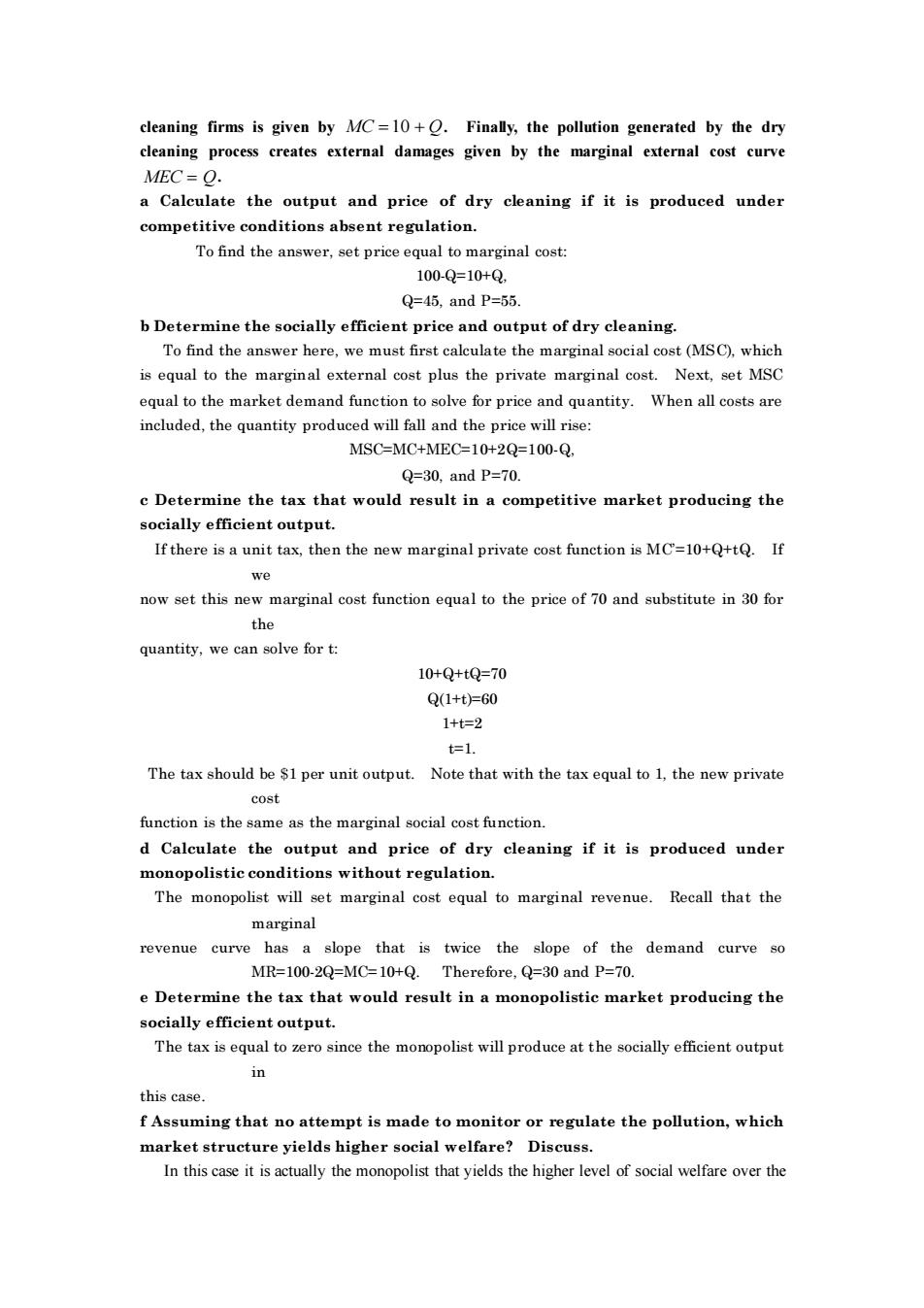
cleaning firms is given by MC=10+.Finally,the pollution generated by the dry cleaning process creates external damages given by the marginal external cost curve MEC=Q. a Calculate the output and price of dry cleaning if it is produced under competitive conditions absent regulation. To find he answer,set priceequal tomarginal cos 100-Q=10+Q. Q=45.and P=55 b Determine the socially efficient price and output of dry cleaning. To find the answer here,we must first calculate the marginal social t(MSC).which is equal to the marginal external cost plus the private marginal cost.Next,set MSC equal to the market demand function to solve for price and quantity.When all costs are included.the quantity produced will fall and the price will rise: MSC-MC+MEC=10+2Q=100-Q. Q=30.andP=70. c Determine the tax that would result in a competitive market producing the socially efficient output. If there is a unit tax,then the new marginal private cost function is MC=10+Q+tQ.If now set this new marginal cost function equal to the price of 70 and substitute in 30 for the quantity,we can solve fort 10+Q+tQ-70 Q(1+t60 1+t=2 t=1 The tax should be $1 per unit output. Note that with the tax equal to 1,the new private cost function is the same as the marginal social cost function. d Calculate the output and price of dry cleaning if it is produced under tions without regulation The monopolist will set marginal cost equal to marginal revenue.Recall that the marginal cevenue curve has a slope that is twice the slope of the demand curve so MR=10-2Q=MC-10+Q Therefore,Q=30 )and P=70. e Determine the tax that would result in a monopolistic market producing the socially efficient output. The tax is equal to zero since the monopolist will produce at the socially efficient output in this case. f Assuming that no attempt is made to monitor or regulate the pollution,which market structure yields higher social welfare?Discuss. In this case it is ally the monopolist that yields the higher level of social welfare over the
cleaning firms is given by MC =10 + Q . Finally, the pollution generated by the dry cleaning process creates external damages given by the marginal external cost curve MEC = Q. a Calculate the output and price of dry cleaning if it is produced under competitive conditions absent regulation. To find the answer, set price equal to marginal cost: 100-Q=10+Q, Q=45, and P=55. b Determine the socially efficient price and output of dry cleaning. To find the answer here, we must first calculate the marginal social cost (MSC), which is equal to the marginal external cost plus the private marginal cost. Next, set MSC equal to the market demand function to solve for price and quantity. When all costs are included, the quantity produced will fall and the price will rise: MSC=MC+MEC=10+2Q=100-Q, Q=30, and P=70. c Determine the tax that would result in a competitive market producing the socially efficient output. If there is a unit tax, then the new marginal private cost function is MC’=10+Q+tQ. If we now set this new marginal cost function equal to the price of 70 and substitute in 30 for the quantity, we can solve for t: 10+Q+tQ=70 Q(1+t)=60 1+t=2 t=1. The tax should be $1 per unit output. Note that with the tax equal to 1, the new private cost function is the same as the marginal social cost function. d Calculate the output and price of dry cleaning if it is produced under monopolistic conditions without regulation. The monopolist will set marginal cost equal to marginal revenue. Recall that the marginal revenue curve has a slope that is twice the slope of the demand curve so MR=100-2Q=MC=10+Q. Therefore, Q=30 and P=70. e Determine the tax that would result in a monopolistic market producing the socially efficient output. The tax is equal to zero since the monopolist will produce at the socially efficient output in this case. f Assuming that no attempt is made to monitor or regulate the pollution, which market structure yields higher social welfare? Discuss. In this case it is actually the monopolist that yields the higher level of social welfare over the
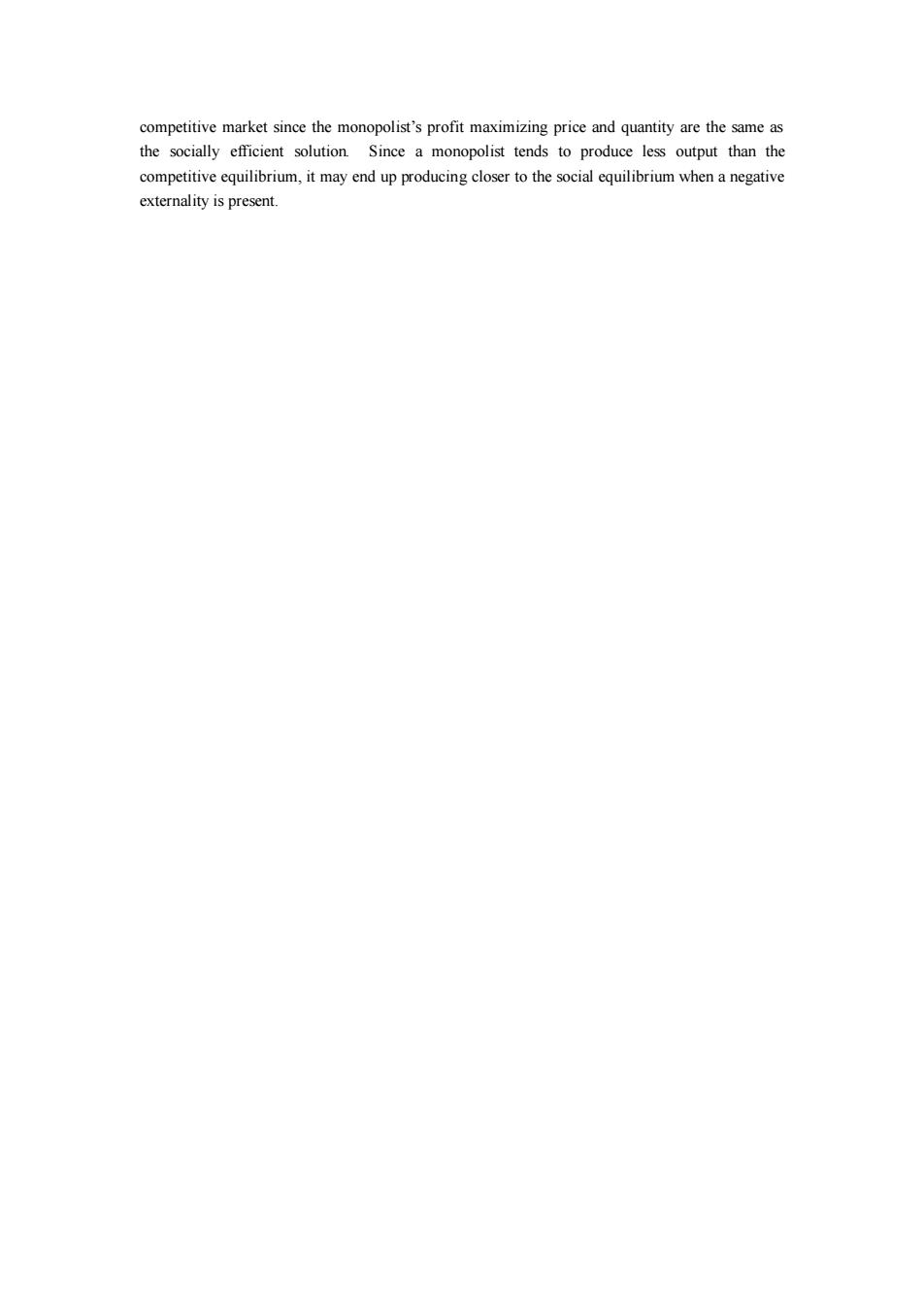
competitive market since the monopolist's profit maximizing price and quantity are the same the socially efficient solution Since a monopolist tends to produce less output than the competitive equilibrium,it may end up producing closer to the social quilibrium when a negative externality is present
competitive market since the monopolist’s profit maximizing price and quantity are the same as the socially efficient solution. Since a monopolist tends to produce less output than the competitive equilibrium, it may end up producing closer to the social equilibrium when a negative externality is present